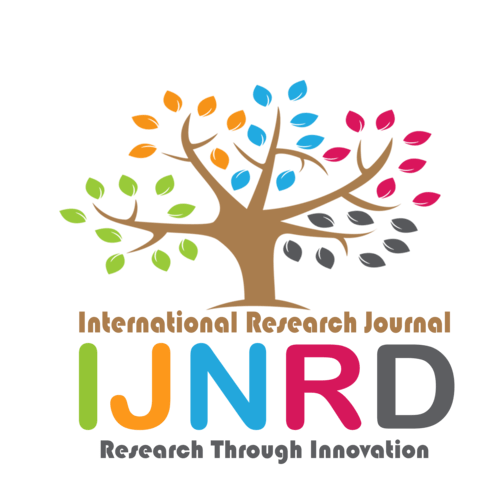|
|||||||||||||||

|
INTERNATIONAL JOURNAL OF NOVEL RESEARCH AND DEVELOPMENT International Peer Reviewed & Refereed Journals, Open Access Journal ISSN Approved Journal No: 2456-4184 | Impact factor: 8.76 | ESTD Year: 2016 Scholarly open access journals, Peer-reviewed, and Refereed Journals, Impact factor 8.76 (Calculate by google scholar and Semantic Scholar | AI-Powered Research Tool) , Multidisciplinary, Monthly, Indexing in all major database & Metadata, Citation Generator, Digital Object Identifier(DOI) |
||||||||||||||
Issue: May 2024
Volume 9 | Issue 5
Review Result and Publication of Paper within : 2-3 days
Click Here For more DetailsFor Authors
Forms / Download
Published Issue Details
Editorial Board
Other IMP Links
Facts & Figure
Impact Factor : 8.76
Issue per Year : 12
Volume Published : 9
Issue Published : 96
Article Submitted :
Article Published :
Total Authors :
Total Reviewer :
Total Countries :
Indexing Partner
Join RMS/Earn 300
Licence
This work is licensed under a Creative Commons Attribution-NonCommercial 4.0 International License







|
Published Paper Details
|
|
| Paper Title: | A COMPARATIVE STUDY TO ASSESS THE EFFECTIVENESS OF BETADINE SITZ BATH AND HALITE SALT SITZ BATH ON EPISIOTOMY PAIN AND WOUND HEALING AMONG POSTNATAL MOTHERS, IN A SELECTED HOSPITAL, BENGALURU. |
| Authors Name: | DAIZY THAKURIA , JOVITA RATHNA ABRAHAM |
| Download E-Certificate: | Download |
| Author Reg. ID: |
IJNRD_203389
|
| Published Paper Id: | IJNRD2308094 |
| Published In: | Volume 8 Issue 8, August-2023 |
| DOI: | |
| Abstract: | ABSTRACT BACKGROUND OF THE STUDY The postpartum period begins immediately after childbirth. During postpartum, women experience discomfort and pain. The pain is mainly associated to perineal area. Perineal pain is the mostly associated after vaginal delivery with episiotomy. The episiotomy pain and poor wound healing are the problems that are generally encounter by the postnatal mothers who have undergone episiotomy. Inadequate management of episiotomy wound can causes infections and longer hospital stay and it may also delays in maternal and child bonding. Sitzbath are the common practices and effective method for perineal wound healing and reducing the episiotomy pain. Sitzbath warm water increases blood flow to the perineal area, this promote faster healing. METHODOLOGY An evaluative approach with Quasi Experimental pre-test post-test only design was used for the study. Puposive sampling technique was used to select postnatal mothers(n=30), which was allocccated in Experimental group I (n=15) and experimental group II (N=15). The Experimental group I received 5ml of 10% betadine sitzbath and Experimental group II received 10mg of halite salt sitzbath. Both the group received the intervention after 6-7 hours of delivery for 15-20 minutes, twice a day for 3 consecutive days. The episiotomy pain was assessed by Numerical Pain Rating Scale and wound healing was assessed by Davidson’s REEDA Scale. The pilot study was conducted from 09/3/21 to 23/03/21. The main study was done during the time period between 30/03/21 to 12/05/21. TOOLS Three tools were used to collect data, they were a demographic proforma, Numerical Pain Rating Scale and Davidson’s REEDA Scale. RESULTS The result for present study illustrated that, for episiotomy pain the Experimental group I (betadine sitzbath), pre-test mean score was 7.93 and standard deviation score was 0.68 and post-test mean score was 5.38 and standard deviation score was 0.83. Whereas, Experimental group II (halite salt sitzbath) pre-test mean score was 7.87 and standard deviation score was 0.96. and post-test mean score was 4.2, standard deviation was 0.91. The comparison between the Experimental group I and Experimental group II, shows a significant difference and it was calculated by using unpaired “t”-test. The degree of freedom was 28 and the value for unpaired “t”-test was 5.13=0.001(P<0.05). For wound healing, among the Experimental group I (betadine sitzbath), pre-test mean score was 3.2 and standard deviation score was 1.17 and post-test mean score was 1.93 and standard deviation score was 093. Whereas, Experimental group II (halite salt sitzbath) pre-test mean score was 3.67 and standard deviation score was 0.77 and pre-test mean score was 1.27 and standard deviation score was 0.57. And the comparison between the Experimental group I and Experimental group II, shows a significant difference and it was calculated by using unpaired “t”-test. The degree of freedom was 28 and the value for unpaired “t”-test was 6.67=0.000015(P<0.05). CONCLUSION The present study concluded that both betadine sitzbath and halite salt sitzbath is effective for episiotomy pain and wound healing. While comparing, the halite salt sitzbath is much more effective than the betadine sitzbath for episiotomy pain and wound healing. |
| Keywords: | Assess, Effectiveness, Betadine Sitzbath, Halite Salt Sitzbath, Episiotomy Pain, Wound Healing, Postnatal Mothers |
| Cite Article: | "A COMPARATIVE STUDY TO ASSESS THE EFFECTIVENESS OF BETADINE SITZ BATH AND HALITE SALT SITZ BATH ON EPISIOTOMY PAIN AND WOUND HEALING AMONG POSTNATAL MOTHERS, IN A SELECTED HOSPITAL, BENGALURU.", International Journal of Novel Research and Development (www.ijnrd.org), ISSN:2456-4184, Vol.8, Issue 8, page no.a799-a805, August-2023, Available :http://www.ijnrd.org/papers/IJNRD2308094.pdf |
| Downloads: | 000118766 |
| ISSN: |
2456-4184 | IMPACT FACTOR: 8.76 Calculated By Google Scholar| ESTD YEAR: 2016 An International Scholarly Open Access Journal, Peer-Reviewed, Refereed Journal Impact Factor 8.76 Calculate by Google Scholar and Semantic Scholar | AI-Powered Research Tool, Multidisciplinary, Monthly, Multilanguage Journal Indexing in All Major Database & Metadata, Citation Generator |
| Publication Details: |
Published Paper ID:IJNRD2308094 Registration ID: 203389 Published In: Volume 8 Issue 8, August-2023 DOI (Digital Object Identifier): Page No: a799-a805 Country: TINSUKIA, ASSAM, INDIA Research Area: Medical Science Publisher : IJ Publication Published Paper URL : https://www.ijnrd.org/viewpaperforall?paper=IJNRD2308094 Published Paper PDF: https://www.ijnrd.org/papers/IJNRD2308094 |
| Share Article: | |
|
Click Here to Download This Article |
|
| Article Preview | |
|
|
|
Major Indexing from www.ijnrd.org
| Semantic Scholar | Microsaoft Academic | ORCID | Zenodo |
| Google Scholar | ResearcherID Thomson Reuters | Mendeley : reference manager | Academia.edu |
| arXiv.org : cornell university library | Research Gate | CiteSeerX | PUBLON |
| DRJI | SSRN | Scribd | DocStoc |
ISSN Details
 |
 |
ISSN: 2456-4184
Impact Factor: 8.76 and ISSN APPROVED
Journal Starting Year (ESTD) : 2016
DOI (A digital object identifier)
Conference
Open Access License Policy
Important Details
Social Media
| Copyright © 2024 - All Rights Reserved - IJNRD |












Facebook Twitter Instagram LinkedIn